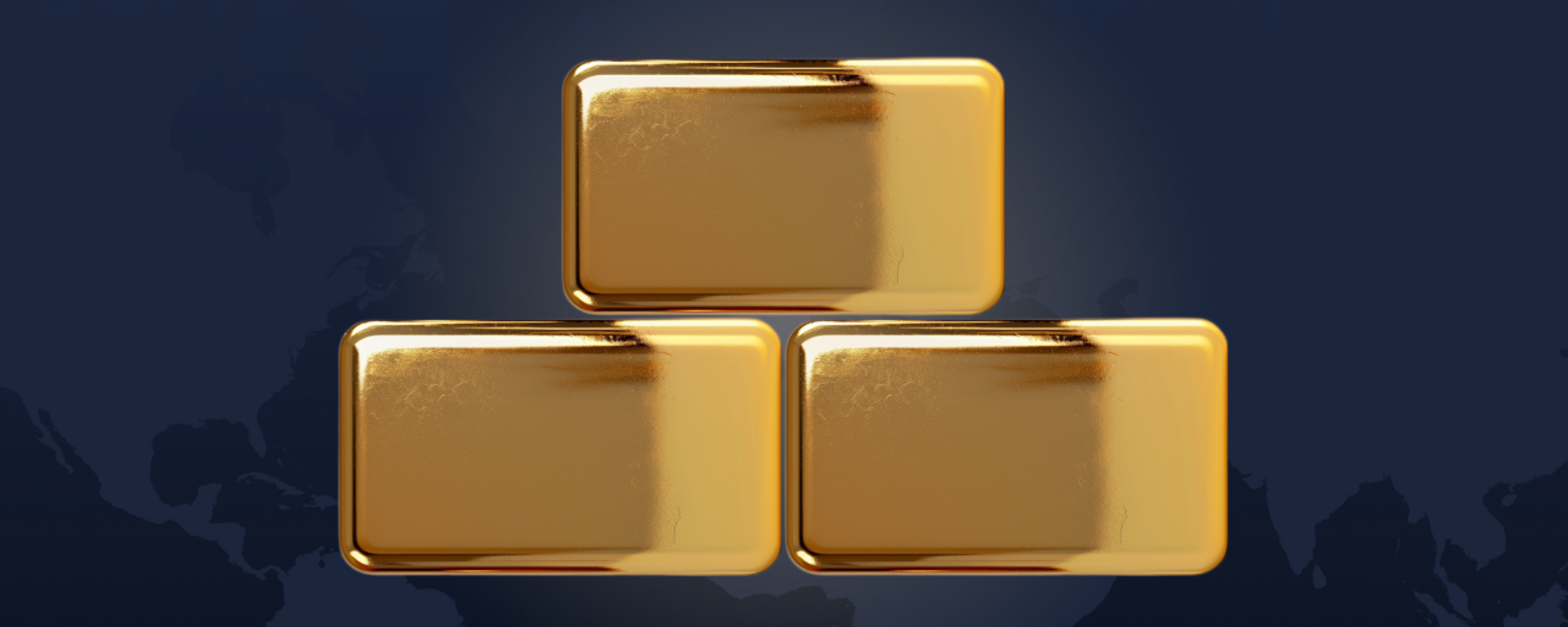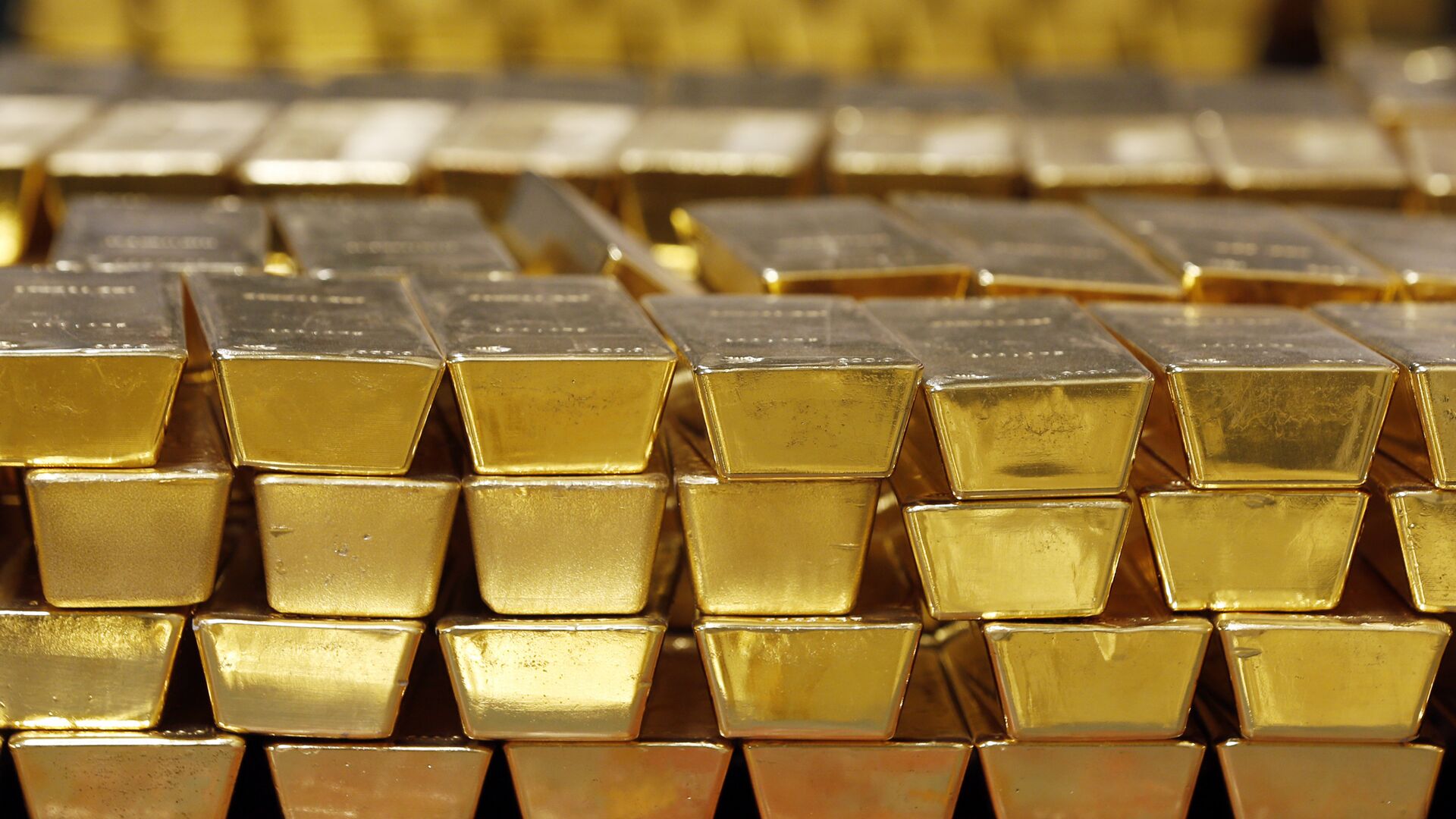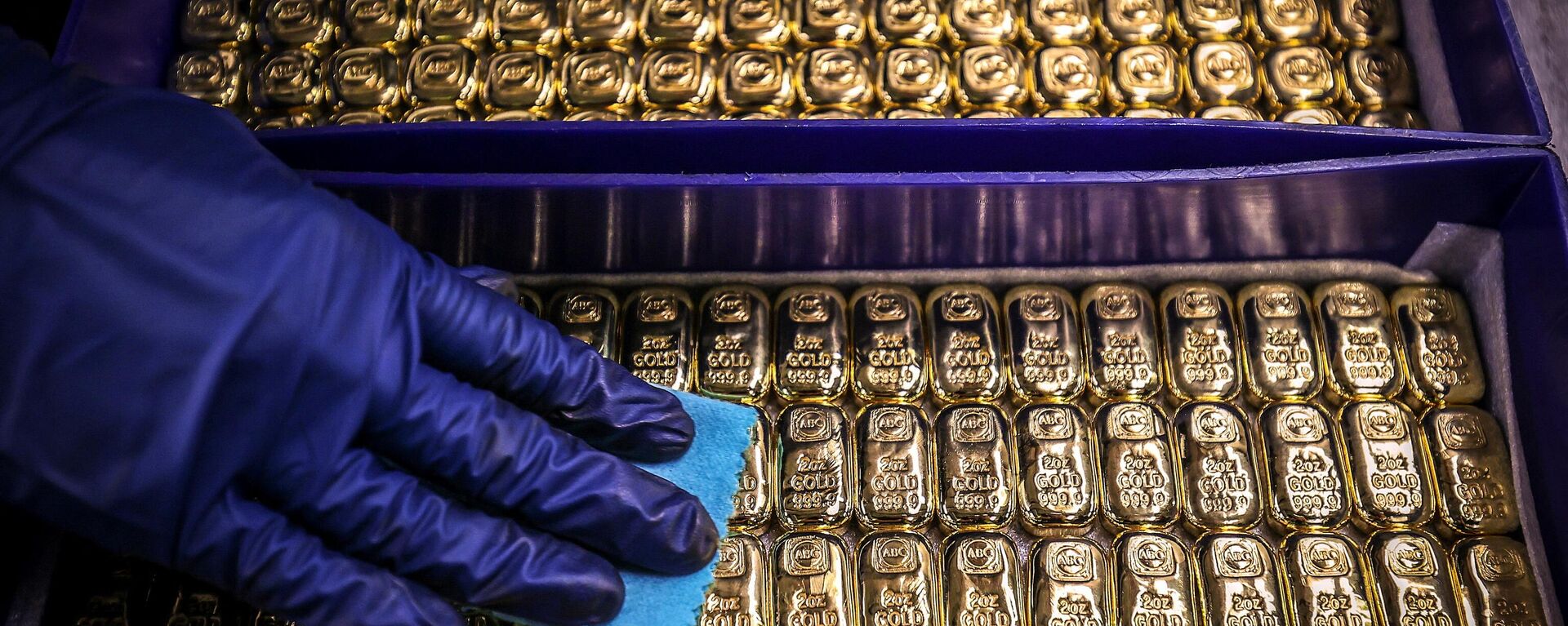https://sputnikglobe.com/20240821/why-is-gold-on-a-bullish-roll-1119855519.html
Why is Gold on a Bullish Roll?
Why is Gold on a Bullish Roll?
Sputnik International
Gold is currently valued at $2,516 per ounce after setting a new record on August 16, eclipsing $2,500 for the first time in history.
2024-08-21T10:12+0000
2024-08-21T10:12+0000
2024-08-21T10:12+0000
economy
economy
gold
gold bullion
business
us federal reserve
safe haven
interest rates
middle east
geopolitical tensions
https://cdn1.img.sputnikglobe.com/img/106377/70/1063777095_0:358:3918:2562_1920x0_80_0_0_f49298241dbbf8070282a6cfb0c7d8bc.jpg
Gold has been trading at $2,516 per ounce after setting a new record on August 16, when it eclipsed $2,500 for the first time in history. Since last year, the price of the precious metal has soared by almost 30%. There is every reason to expect further gains. Let's take a closer look at what is driving this bullish trend.Fed's Monetary PolicyGold soars on the prospect of further interest rate cuts by central banks, led by the US Federal Reserve. As a rule, the precious metal’s price goes up when interest rates go down, since lower rates diminish the likely yields, or returns, from bonds and shares.Investors are waiting for Federal Reserve Chair Jerome Powell’s speech on August 23 at the Jackson Hole Symposium for hints on further rate cuts. Traders expect a total of 100 bps in rate cuts by the US central bank in the three remaining decisions this year.Other central banks have been cutting interest rates. The European Central Bank carried out a 0.25% cut in June, and the Bank of England cut rates to 5% from 5.25% in August.Economic uncertainty boosts demand for gold. After the release of the weak US jobs report in July, gold prices soared over fears of an upcoming recession.Dollar DeclineIn anticipation of rate cuts, the US dollar fell by 2.2% against the combined strength of rival currencies, while the yield on the benchmark 10-year US Treasury note sank too, making bullion more attractive.Central banks have been buying up gold, with net purchasing in H1 amounting to 483 tons. At the same time, their holdings of dollar-denominated assets reached a historic low amid US weaponization of the greenback. Dollar and US Treasury-denominated foreign reserves hit 58.9% in 2024, down from about 70% two decades ago, per a Nikkei-cited report.China has led the bullion buy-up, with the People’s Bank of China bolstering gold purchases by 30% last year. Gold reserves in China increased to 2,264.32 tons in the second quarter of 2024. India has also stacked up its gold-denominated assets, currently worth $57.6 billion.Russia's gold reserves reached an all time high of 2,335.85 tons in the second quarter of 2024, according to the World Gold Council.As part of the de-dollarization trend embraced by BRICS countries, many other states have been motivated to follow their example to dodge the risks of storing central bank assets in foreign countries.Geopolitical TurmoilThe ongoing NATO proxy war in Ukraine, Israel’s war on Hamas in Gaza, risks of a full-blown conflict with Lebanon and Iran, and the Yemeni Houthi militia’s campaign of drone and missile attacks targeting suspected Israeli-owned vessels and US and British warships in the Red and Arabian Seas are fueling the gold-buying spree. The looming US presidential election and the corresponding future foreign policy course add to the uncertainty. Against this backdrop, central banks are likely to continue ditching the dollar and other fiat currencies in favor of stacking up gold holdings.
https://sputnikglobe.com/20240509/brics-blocs-bullion-buy-up-buoys-trend-toward-dedollarization-1118365980.html
https://sputnikglobe.com/20240819/how-the-wests-mass-media-got-it-all-wrong-about-gold-1119826271.html
Sputnik International
feedback@sputniknews.com
+74956456601
MIA „Rossiya Segodnya“
2024
News
en_EN
Sputnik International
feedback@sputniknews.com
+74956456601
MIA „Rossiya Segodnya“
Sputnik International
feedback@sputniknews.com
+74956456601
MIA „Rossiya Segodnya“
what is the price of gold, is gold on a bullish trend, how much is gold currently valued, what historic record did gold set, how high is the cost of gold, will gold replace the dollar, is gold a good asset, when is gold a good asset, is gold as good as dollar, is gold better than dollar, why is the price of gold soaring, why is value of gold going up, how much has the price of gold grown in a year
what is the price of gold, is gold on a bullish trend, how much is gold currently valued, what historic record did gold set, how high is the cost of gold, will gold replace the dollar, is gold a good asset, when is gold a good asset, is gold as good as dollar, is gold better than dollar, why is the price of gold soaring, why is value of gold going up, how much has the price of gold grown in a year
Why is Gold on a Bullish Roll?
Gold tends to be seen as a safe haven during economic and geopolitical turbulence, as is currently witnessed by the increasingly bullish trend displayed by the yellow metal.
Gold has been trading at
$2,516 per ounce after setting a new record on August 16, when it eclipsed $2,500 for the first time in history. Since last year, the price of the precious metal has soared by almost 30%. There is every reason to expect further gains.
Let's take a closer look at what is driving this
bullish trend.
Gold soars on the prospect of further interest rate cuts by central banks, led by the
US Federal Reserve. As a rule, the precious metal’s price goes up when interest rates go down, since lower rates diminish the likely yields, or returns, from bonds and shares.
Investors are waiting for Federal Reserve Chair Jerome Powell’s speech on August 23 at the Jackson Hole Symposium for hints on further
rate cuts. Traders expect a total of 100 bps in rate cuts by the US central bank in the three remaining decisions this year.
Other central banks have been cutting interest rates. The European Central Bank carried out a 0.25% cut in June, and the Bank of England cut rates to 5% from 5.25% in August.
Economic uncertainty boosts demand for gold. After the release of the
weak US jobs report in July, gold prices soared over fears of an upcoming recession.
In anticipation of rate cuts, the
US dollar fell by 2.2% against the combined strength of rival currencies, while the yield on the benchmark 10-year US Treasury note sank too, making bullion more attractive.
Central banks have been
buying up gold, with net purchasing in H1 amounting to
483 tons. At the same time, their holdings of dollar-denominated assets reached a historic low amid US
weaponization of the greenback. Dollar and US Treasury-denominated foreign reserves hit 58.9% in 2024, down from about 70% two decades ago, per a
Nikkei-cited report.
China has led the bullion buy-up, with the People’s Bank of China bolstering gold purchases by 30% last year. Gold reserves in China increased to 2,264.32 tons in the second quarter of 2024. India has also stacked up its gold-denominated assets, currently worth $57.6 billion.
Russia's gold reserves reached an all time high of 2,335.85 tons in the second quarter of 2024, according to the World Gold Council.
As part of the de-dollarization trend embraced by
BRICS countries, many other states have been motivated to follow their example to dodge the risks of storing central bank assets in foreign countries.
The ongoing
NATO proxy war in Ukraine, Israel’s
war on Hamas in Gaza, risks of a full-blown conflict with Lebanon and Iran, and the Yemeni Houthi militia’s campaign of drone and missile attacks targeting suspected Israeli-owned vessels and US and British warships in the Red and Arabian Seas are fueling the gold-buying spree.
The looming US presidential election and the corresponding future foreign policy course add to the uncertainty. Against this backdrop, central banks are likely to continue ditching the dollar and other fiat currencies in favor of stacking up gold holdings.

19 August 2024, 11:41 GMT




